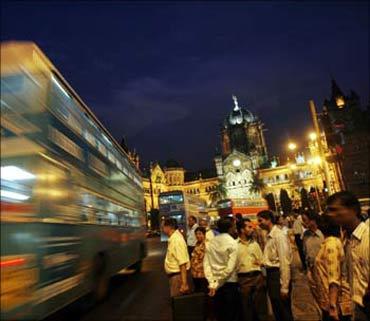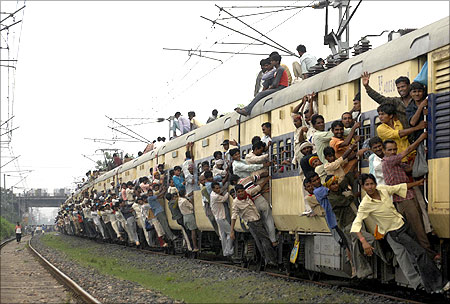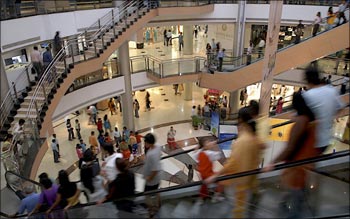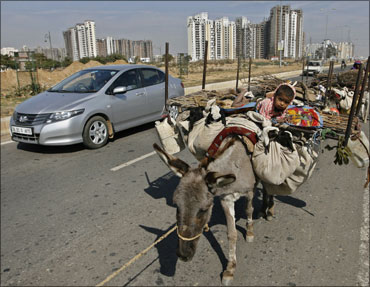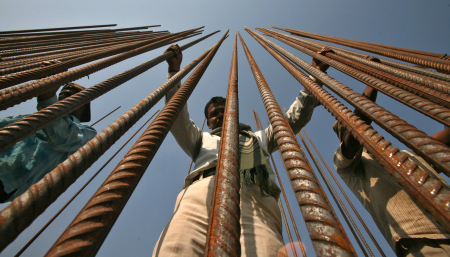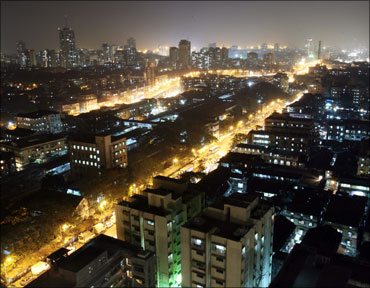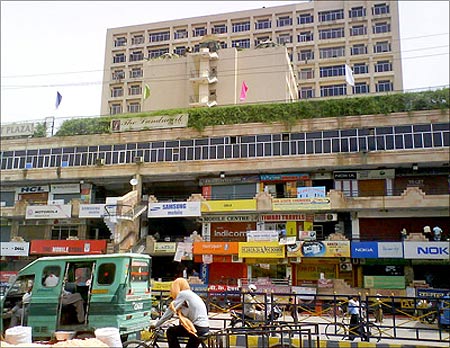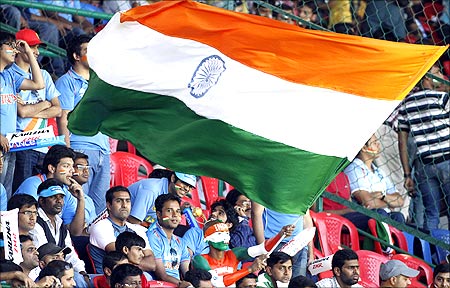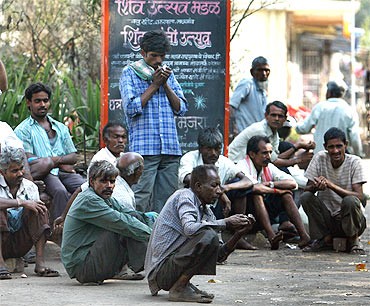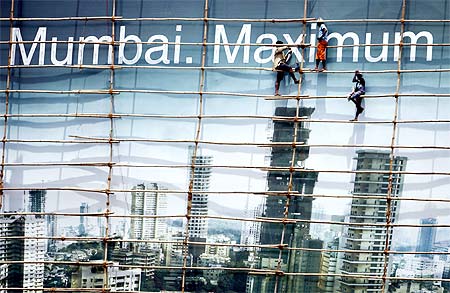 | « Back to article | Print this article |
'India to see BIGGEST urban migration in next 15-20 years'
India needs to create 220 million jobs in the next 15 years and this is only possible by implementing the National Manufacturing Policy, launched recently by the government, says Arindam Bhattacharya, managing director, The Boston Consulting Group (BCG) India Pvt Ltd.
In a conversation with Business Standard, he explains why it is time for some bold policy decisions to sustain the current rate of growth, and that the country has limited choice in terms of creating growth and jobs. Edited excerpts:
Is the 14 per cent annual manufacturing growth achievable by 2022 as envisaged in the National Manufacturing Policy (NMP), especially when growth has fallen in the sector?
About two years earlier, BCG had produced a report with CII (Confederation of Indian Industry) on the manufacturing sector, where we questioned what was the baseline and what is it we need to achieve.
If you look at the baseline, the growth of manufacturing over 30-40 years had increased every decade but since 2000, our annual GDP growth rate had been seven-eight per cent on an average, making us the second fastest growing country in the world.
Only China was growing faster than us.
Click NEXT to read on . . .
'India to see BIGGEST urban migration in next 15-20 years'
But the problem with the baseline was the share of manufacturing in GDP and the jobs being created in the sector over 15-20 years.
When India started industrialising, in the first few decades the manufacturing sector grew faster than GDP, primarily because we had a small base.
Its share in GDP grew from nine per cent to 15 per cent till about 1980. Since 1980, even as the sector got liberalised and its growth rate also increased, its share in GDP largely remained stagnant, at 15-16 per cent.
Comparatively, in other emerging economies, the share of manufacturing to GDP was 20-40 per cent. It is the highest in Thailand, at 40 per cent, and in China, it is around 35 per cent.
Click NEXT to read on . . .
'India to see BIGGEST urban migration in next 15-20 years'
Also, in the past 10 years, manufacturing in the organised sector has not added a lot of jobs; job creation had been mostly in the unorganised sector.
In the next 15-20 years, the challenge India will face is creation of jobs. India needs to create 220 million jobs between now till 2025.
In an economy at this stage development, a large chunk have to come from manufacturing.
Also, in the next 15-20 years, India will see the largest migration in history that has ever happened from rural to urban areas. To feed the growing population, we have to increase our food productivity.
Second, today 55 per cent of employment is still in agriculture, of which a large part of it is disguised unemployment.
To increase agricultural productivity, we have to reduce this; where, then, will these people go? So India needs manufacturing to grow.
It is also clear that manufacturing has to grow a couple of percentage points higher than that of GDP, to be able to increase its share and create the jobs.
Click NEXT to read on . . .
'India to see BIGGEST urban migration in next 15-20 years'
Does the NMP address all these concerns adequately?
The NMP addresses the objective of increasing the share of the sector to the country's growth rate, providing 100 million jobs (by 2022) and making India a lot more competitive.
We do not have a choice. There are a couple of policy ideas and specific steps suggested. Within those steps, the most important provision is the creation of National Investment and Manufacturing Zones (NIMZ).
There are two theses behind this.
First, India needs large-scale manufacturing zones for a variety of reasons -- scales give that advantage, scales give clusters and we have seen that in other emerging economies, manufacturing grew at a faster rate because of these large-scale zones.
Click NEXT to read on . . .
'India to see BIGGEST urban migration in next 15-20 years'
Also, the NIMZs reduces the regulatory burdens on a company, creating self-certification on the one hand and giving clearance power to the CEO of the SPVs (Special Purpose Vehicles) that will run these NIMZs.
So, in many ways, it will create a lot more comparative ecosystems for the manufacturing units in those zones. Our current regulatory framework creates a lot of constraints on industry.
Second, for the first time, a government policy talks about making it easier for companies to align their labour force according to market requirements.
So, the policy makes some specific recommendations on labour, keeping in mind workers' rights in terms of a sinking fund, insurance policy and their training.
Last, the policy talks of investments in green technology. So, NIMZ is a big driver, it could be a game-changer but I think there could be significant implementation challenges that need to be worked out in detail.
Click NEXT to read on . . .
'India to see BIGGEST urban migration in next 15-20 years'
Is it true that labour laws were being compromised in the NMP and empowering the SPVs would prove a problem area?
I have a simple view on this. We need to grow manufacturing higher than the GDP, which basically means that if our GDP growth rate in the next 15 years is around eight-nine per cent a year, the manufacturing sector has to grow at 12-14 per cent.
Do we have a choice here? Till now, we have not been able to grow consistently at this pace.
Industry points to the time it spends in getting environmental clearances, the time, costs and man-months required to adhere to the regulatory policies ranging from the Factories Act, the Boilers Act, to all those Acts that require submission of hundreds of documents, and for each of those decisions there is a discretionary power that rests with the inspectors, that also has cost implications.
Click NEXT to read on . . .
'India to see BIGGEST urban migration in next 15-20 years'
In an economy growing by eight per cent a year, why have we not grown organised labour in the manufacturing sector? We do not look at the outcome, we only look at the inputs.
The current environment has not produced the jobs and unorganised jobs have no rights, they are low-paid and they do not have protection.
So the question is not of empowering the SPVs or relaxing labour rules; the question is what is required to make NIMZs successful and create jobs and make the companies compete globally.
If it means we need greater flexibility of labour, the question we should ask is how we can offer flexibility by taking care of workers' rights.
Click NEXT to read on . . .
'India to see BIGGEST urban migration in next 15-20 years'
Do you see a smooth road ahead in effectively implementing the NMP?
Today, economic issues are turning more and more complex. A decision taken on some sectors has implications on the upstream and downstream industries.
The growth of manufacturing cannot be only driven by the ministry of commerce and industry. To make it successful, you require power, land, labour, environment and foreign investment and all of these would drive manufacturing growth.
If we do not have a process that can bring alignment, then there is a problem. And, a lot of these are state subjects. So, these are challenges to the governance problems. More, today, civil society also plays a huge role.
Click NEXT to read on . . .
'India to see BIGGEST urban migration in next 15-20 years'
So, my question is to rethink our governance models. We need the next level of innovation there to be able to push complex inter-ministerial and inter-state initiatives like the NMP.
NIMZ is one of the levers; then there is the lever of government procurement, which is huge. We are always pushed to the wall when it came to reforms and, very interestingly, that happened within a period of every 10 years.
The same thing is happening now. You have to build political consensus at different levels across different states. An improved governance can make it successful and history has shown us that.
Do you think it is time India allows foreign direct investment (FDI) in multibrand retail trading and the decision to stall the move until a political consensus was built was counter-productive?
Having made the announcement and then going back was clearly counter-productive.
As long as it was not put on the agenda so actively and announced publicly by the prime minister and others, it would have been better.
On the other hand, we need this. We need to allow FDI in multi-brand retail. We need to significantly increase flows into our country.
Click NEXT to read on . . .
'India to see BIGGEST urban migration in next 15-20 years'
There are three kinds of flows -- external borrowing, foreign institutional investments (FIIs) and FDI. We do not generate enough investible cash, so the only way out to maintain this kind of a growth rate is FDI and FIIs.
Our FDI level has to grow by three times from what it is now. So, we need to have FDI inflows of $80-100 billion a year in the next couple of years.
We can do that only by making India attractive and bringing money in the sectors that have potential to also generate jobs. We need higher growth, for which we need FDI, to pay for food security programmes and schemes like NREGA.
There needs to be the right kind of communication and debate to address this vital issue. Today, we have a huge problem in agriculture productivity, we have huge problems in wastage, the supply chain, technical and managerial skills.
Click NEXT to read on . . .
'India to see BIGGEST urban migration in next 15-20 years'
This was one opportunity where we could have brought in investments and skills. We need to have an informed debate on the pros and cons of every decision taken.
Bring the three main stakeholders -- the farmer, trader and consumer - involved in this issue into a platform and have a debate and then analyse.
What is your reading on the macroeconomic situation of India? How do you see the impact of the falling rupee?
My sense is that the government and the Reserve Bank of India (RBI) expected a 10 per cent fall of the rupee and they were prepared on that.
One of 20 per cent did take them by surprise. I believe India has a growth engine in place, driven by a young population and a growing per capita income, coupled with increased investments.
This would be a monotonic growth, as these factors will continue to remain there, unless some dramatic event occurs. This should actually strengthen the rupee.
Click NEXT to read on . . .
'India to see BIGGEST urban migration in next 15-20 years'
So, this fall in the rupee is fairly a localised phenomenon. As we get inflation under control and take some bold policy decisions, which we have to, no matter what, growth will continue to happen and the rupee will start strengthening again.
Also, as the crisis in the Eurozone plays out and as the risks start reducing, my sense is that by the first quarter of the next financial year, it would be around to a level of 50 to a dollar and, eventually, by the end of the next financial year, it would correct itself.
India Inc has indicated gloom, while holding on to investments. What is your opinion on the reduced business sentiment? Has too much monetary tightening by the RBI now showing on all major economic indicators?
When I look back when UPA-II came to power, there was such a strong business confidence, I think of what is it that has changed fundamentally. More than the global financial meltdown, the problem of inflation has taken the confidence away.
Click NEXT to read on . . .
'India to see BIGGEST urban migration in next 15-20 years'
Then, political opposition got accentuated due to scams such as the 2G scam and mining scam. Moreover, there had been a hike in interest rates that have affected business sentiment and a fall in the growth rate from eight per cent to 6.5 per cent.
Monetary policy can only have so much impact in containing an inflation which has risen mainly due to supply-side constraints.
RBI is going to take a corrective step but the question is whether they will take a major step or several small steps.
The rate hike has reached its peak, I think it is now on a downward curve.
How robust is the Indian banking system today, with its exposure to so many sectors? Will we be able to come out successfully? Should we follow the European stress-test mechanism for our banks?
Our sunrise sectors in the last decade were telecom, infrastructure, power, aviation, retail and financial services.
In all these, large investments were made and all of them today are struggling for profits as a sector. Their return on capital was also low due to the structural issues in these industries.
Click NEXT to read on . . .
'India to see BIGGEST urban migration in next 15-20 years'
And, the banking sector has invested hugely in them, so obviously that sector is under stress. We need to, thus, look at these sectors separately. The banks cannot even stop giving them money.
So, there are limited options. Either the government recapitalise these banks or we get more FDI, something China did. There are many who still believe in India's growth story.
Do you agree with the policy paralysis thesis?
I would not call it a policy paralysis. I think the government got too preoccupied with other issues, rather than taking key economic decisions.
The whole Anna Hazare issue became a black swan (disproportionate role of a hard-to-predict and high-impact event) for the government. All energy of the government was directed to address these challenges.
The government did take many decisions, identified many things but somehow they were not able to push through these decisions. So, I will not call it paralysis but bad management.
